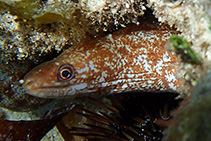| Family: |
Muraenidae (Moray eels), subfamily: Muraeninae |
| Max. size: |
50.5 cm TL (male/unsexed) |
| Environment: |
reef-associated; marine; depth range 0 - 45 m |
| Distribution: |
Indo-Pacific: South Africa and Oman to the Hawaiian and Society islands, north to the Ryukyu and Ogasawara islands, south to northern Australia and the Loyalty Islands. |
| Diagnosis: |
Dorsal spines (total): 0-0; Dorsal soft rays (total): 0-0; Anal spines: 0-0; Anal soft rays: 0-0; Vertebrae: 121-133. Body light brown, with dendritic pattern. Corner of mouth with a dark brown spot, preceded on lower lip by a large white blotch (often followed by another above and behind corner of mouth); upper and lower jaw pores usually in prominent white spots. Vertebrae 121-133.
Description: Characterized by body depth at gill opening about 18-20 in TL; origin of dorsal fin at about midway between gill opening and corner of mouth; anus located near middle of body; single row of jaw teeth in anterior part of jaws; posterior canines usually alternating with 1-2 small teeth; three longest median canines at front of upper jaw; females, side of jaw with two rows of teeth, 1-3 elongate teeth in inner row (no inner teeth in male); front of lower jaw with two rows of teeth, inner row longest (Ref. 90102). |
| Biology: |
Occurs in shallow coastal reef flats, usually found in less than 5 m water depth, but ranges to deep water rubble reefs (Ref. 48635). Benthic (Ref. 58302). Minimum depth reported taken from Ref. 86942. |
| IUCN Red List Status: |
Least Concern (LC); Date assessed: 17 August 2011 Ref. (130435)
|
| Threat to humans: |
harmless |
Source and more info: www.fishbase.org. For personal, classroom, and other internal use only. Not for publication.
